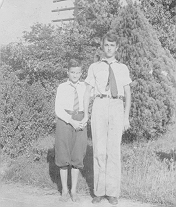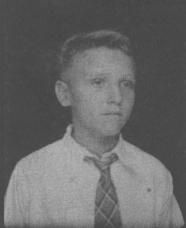BONNY OAKS EXCERPT FROM
GEORGE EDWARD HATCH’S
AUTOBIOGRAPHY
Bonny Oaks was a large farm located east of
Chattanooga. They grew several
hundred acres of corn, hay, soybeans and truck gardens. There were also large dairy herds, pigs, chickens, sheep and
honeybees. The overall manager was
Dr. W.S. Keese. The farm manager
was Mr. Manning. Mr. Hagan managed
the dairy and other livestock. There
were 40 or 50 white boys, about 25-30 girls and 40-50 colored kids. They all lived in separate sections of the farm.
The boys’ dormitory was divided in two age groups.
Eleven and under were considered younger boys.
The older boys were at least twelve.
The older boys did all of the farm and dairy work under the supervision
of Mr. Manning and Mr. Hagan. The
younger boys worked in the kitchen, cleaned the dormitory, did the laundry and
kept the yards clean. Mrs. Manning and Mrs. Scott were the two housemothers in
the boys’ building. Mrs. Manning
was in charge of housekeeping and seeing that we had clean clothes and were all
kept clean. She was so particular
we were not allowed on the second floor where the younger boys’ dorm was with
our shoes on. We had to take our shoes off and leave them on the stairs. Then just about all the shoes had black soles and they would
leave marks on the beautiful hardwood floors.
Mrs. Scott was in charge of the kitchen and she made sure that we were
all well fed with nourishing food.
December 21 1935 my life took another change.
At the age of 11 years and 11 months, and after 7 years of a loving care
institution at Pine Breeze where we were required to rest 4 to 6 hours every
day, I was suddenly pushed into an environment where everybody had to work.
Even with the differences in environment, my short stay at Bonny Oaks was
filled with lots of work and play, mostly play. The first work I can remember ever doing was at Bonny Oaks.
Not long after I went there, I started helping in the kitchen, washing dishes,
peeling potatoes, setting and cleaning tables.
Sometimes we would get to help with the cooking.
Some days after lunch, Mrs. Scott would make cookies for all the boys.
Of course, the kitchen help got first pickings.
One thing everyone wanted to do was help Charles
Robison make bread. Charles was one
of the older boys. He made all the
biscuits and cornbread. He had to
do this with an old coal stove that half the time would not get hot enough and
would smoke inside the kitchen so bad the bread would taste like coal smoke.
In spite of the big black monster, “the stove”,
we were all very blessed with good healthy food thanks to Charles Brannon who
was in charge of the cannery. The
cannery put up one-gallon cans of green beans, tomatoes and any other vegetables
that could be put in cans. They also put up a lot of fruit.
Working in the kitchen was where I came to know
Charles and Lester B. Robison. L.
B. and I later became foster brothers and lifelong friends.
Sometimes when Mrs. Scott had to go to town, she
would take one or two of us boys with her.
This was always a treat because it was the only time we got to go to
town. She would drop us off at a
drug store in East Chattanooga and give us money to buy candy and a coke.
We would wait outside of the drug store and watch the streetcars while
she shopped. On one of the trips to
town we were sitting in front of the drug store when a small girl was hit and
killed by a car across the street from where we were sitting.
Some little things you don’t ever forget:
There was a wild plum thicket about a mile from our
building where I picked plums for Mrs. Scott to make into jelly for us kids.
There was an apple tree by the railroad track that
was over grown with honeysuckle vines. I
had climbed ten or twelve feet up in the vines to get apples when I suddenly
found myself face to face with a small green snake.
It was about a foot from my nose. It
looked like a monster to me and needless to say I turned loose and fell out of
the tree. The vines were so thick and I was so small that I wasn’t
hurt, but it ended my tree climbing for apples.
In the summer the long evenings were always fun
times. Unless it was raining we had
to stay outside except to go to the bathroom.
We had several acres of playground and there were always games going on.
Some of the most popular games were marbles, mumble
pegs, horseshoe pitching, touch football, baseball and other outdoor games. If
you were lucky enough, you had a wheel and hoop to push all over the playground.
This was a wheel about 15 or 20 inches across and a stiff wire bent on the end
to push and guide the wheel. I must
have pushed a wheel a hundred miles in the 1 year I was there.
Every three or four weeks in the summer Mr. Hagen would take a truckload
of us to Chickamouga Creek swimming. It
was out in the country twenty miles or so away from Bonny Oaks.
When the weather was too bad to play outside, we had a large playroom
downstairs where we played checkers, dominoes and other board games.
We also had books and other reading material. I could always find a good book to read or bounce a tennis or
rubber ball off the concrete wall in the playroom. I spent a lot of time doing
this.
January 21, 1936 I became one of the older boys. I
thought I could go to the Boy Scout hut, roller-skating and on hay rides and
other things they got to do, but because I was so little, behind in school and
lacked the social skills, I missed most of the things they did.

George Hatch, age 15,(left)
and brother, Marshall Hatch.
Bonny Oaks in 1939.
In the summer of
1939, Miss Pryor and her mother brought my brother Marshall to visit me. Miss
Helen Pryor was a high school teacher at Tyner High School where the older boys
and girls at Bonny Oaks went to high school.
She took Marshall in as a foster son when he was 15 years old. This was
the second time I can remember seeing Marshall until I was 15.
I remember seeing him one other time when I was seven or eight.
He came to Pine Breeze one afternoon.
He was at Bonny Oaks at the time and I remember that he had a broken arm
from cranking a tractor that backfired.
In the spring after my 12 birthday another boy, “ I
don’t remember his name” and myself decided to run away.
We didn’t know where we were going or what we were going to do, we just
ran away. I guess it sounded like
the thing to do. That morning we saved a couple of biscuits apiece and took
off right after breakfast. We
walked on the railroad track all day and were picked up in the first town we
came to. Dr. Keese came and got us. Our
punishment was one week in bed with only bread and water to eat, but we didn’t
have to do without we had too many little friends to go hungry.
The most important event and decision of my life
occurred late in the summer of 1936 at the age of twelve.
Mrs. Scott invited two or three of us boys to go with her to a week’s
revival at the Highland Park Baptist Church in Chattanooga.
It was at this revival that I was saved and baptized.
I haven’t always lived a good Christian life, but I have never
forgotten my Christian faith. I thank God for Mrs. Scott who was caring and
concerned enough to give me this opportunity.
During the year that I was at Bonny Oaks, there were
several boys and girls placed in foster homes.
Some would soon return and some I never heard from again.
I knew a few that found a good home and did quite well.
Oct. 1936 I was told that L.B. Robison and my self
were to be placed in a home on Sand Mountain in Alabama.
Neither of us had ever heard of Sand Mountain.
We were not told anything about the home or the family.
Since I could not remember ever living in a home or with a family I
didn’t know what to expect and wasn’t to sure I wanted to go.
I don’t think I had a choice and I was afraid. This soon passed, as we were welcomed to our new home.

Lester B. Robison in 1935.
Just before going to Sand Mountain
With L. B. it was
different. He had lived in a home
with his mother, brothers and sisters. At
the time I did not know why L.B and his brother Charles were sent to Bonny Oaks.
His brother was later sent to a foster home in Georgia.
I have since learned that his father had died and that his mother could
not take care of them. I could not
have found a better companion. We became more like brothers and we still keep in
touch.
We were given what little clothes we had and a little
money and were put on a train to Fort Payne Alabama.
I was 12 years old and L. B. was 13.